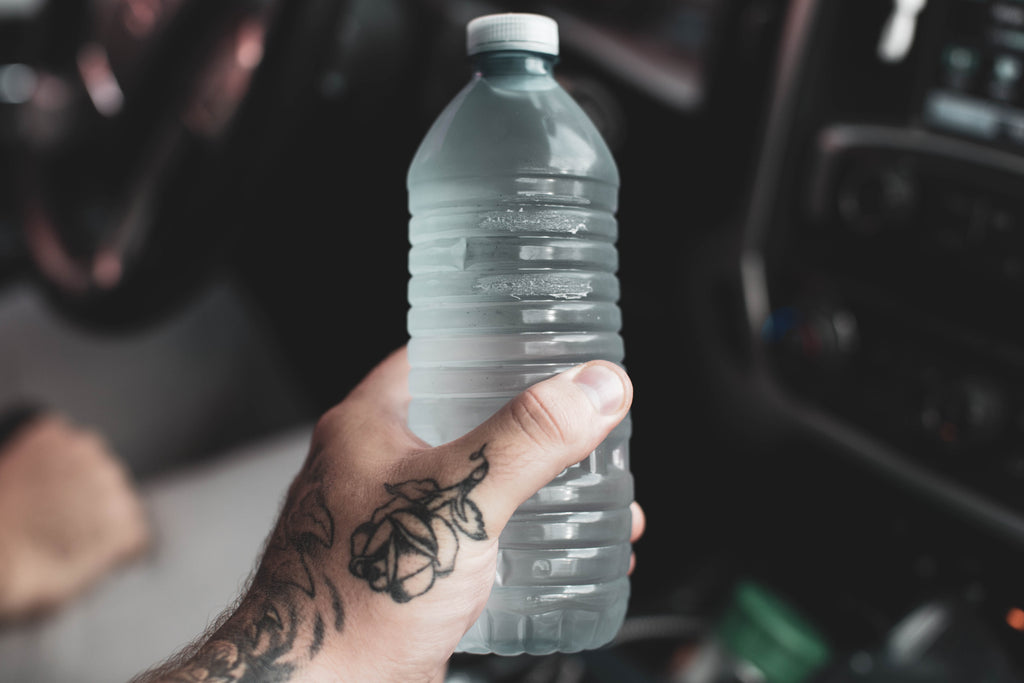
In an age where environmental consciousness is on the rise (thank f*ck), a silent, malevolent invader lurks in the most unsuspecting places: our bottled water. This blog delves into the unseen world of microplastics, the tiny particles with potentially nasty effects on human health. We'll explore recent research findings, the health implications of these particles, and what it means for our everyday choices regarding bottled water consumption.
WHAT ARE MICROPLASTICS?
Microplastics are small plastic pieces, typically less than five millimetres in size. They originate from a variety of sources, including the degradation of larger plastic items, cosmetic products, and even clothing (polyester doesn't come from plants! Bring back the magical, all encompassing hemp! But that's for another blog!). These minuscule particles eventually find their way into our water systems, food supply – and alarmingly, into the bottled water many of us consume daily.

MICROPLASTICS IN BOTTLED WATER - THE RESEARCH FINDINGS
Recent research has raised significant concerns about the presence of microplastics in bottled water. A ground-breaking study by Columbia University revealed that bottled water can contain up to 240,000 microplastic particles per litre, this is 10 to a 100 times more than previously thought. The World Health Organization (WHO) has also acknowledged the presence of microplastics in both tap and bottled water (we are well aware that the WHO aren't always the most trusted source of information, although this one we can believe). A study by Orb Media found that an overwhelming 93% of bottled water brands tested showed traces of microplastics, with some brands containing 50% more microplastics than tap water.
HEALTH IMPLICATIONS OF MICROPLASTICS
The potential health risks of microplastic consumption are a growing area of concern. Nanoplastics, a smaller subset of microplastics which are one-one thousandth of one-one thousandth of a millimetre, are particularly alarming due to their ability to penetrate human tissues and organs, including the brain and heart. Furthermore, plastics such as polyethylene terephthalate (PET), Bisphenol A (BPA), and a chemical plasticizer otherwise knows as Phthalates, commonly used in water bottles, have been associated with endocrine disruption and other health issues.

WHAT ARE PHTHALATES AND WHY WE SHOULD BE CONCERNED
Phthalates, also known as phthalate esters, are a group of chemicals commonly used to make plastics more flexible, durable, and transparent. They act as plasticizers, adding those desirable qualities to various common products most of us use everyday, including food packaging and water bottles, toys, cosmetics and other personal care products.
Phthalates can enter the body through ingestion, inhalation, and skin absorption. While the full extent of their impact on human health is still being studied, concerns have been raised about phthalates acting as endocrine disruptors. This means they can interfere with hormone function, potentially leading to adverse effects on male reproductive development, birth outcomes, and other health issues. It looks particularly bad for men, as phthalates disrupt male genital development, there have been studies in pregnant rats (poor souls, Rat Assed express our condolences), that phthalate exposure leads to abnormal development of male genitalia in the offspring. This includes smaller penis size, shorter anogenital distance (distance between the anus and the genitals), and undescended testicles. It appears that shorter anogenital distance correlates with lower sperm counts in men.
COMPARING BOTTLED WATER TO TAP WATER
When it comes to microplastic content, there appears to be a marked difference between bottled and tap water. Bottled water has been found to contain more microplastics compared to tap water, which is subject to more rigorous testing and quality standards. This raises questions about the perceived safety and purity of bottled water.

ADDRESSING THE ISSUE
To mitigate the risks posed by microplastics, consumers can take proactive steps. One such measure is to reduce reliance on bottled water and switch to safer, more sustainable alternatives like filtered tap water. You can check out brands like Brita to make the switch. Or beer? Although it's still 93% water, that makes it 7% better for us? Right?
Why not support a sustainable, rebellious fashion brand like Rat Assed, by purchasing one of our stainless steel Blue or Pink Mascot Rat reusable bottles! Not only will you be doing your own health a kindness, but the planet too! We will donate at least 10% of all profits to clean up organisations around the UK, removing the nasty plastics from the natural environment, through litter picking. We also get stuck in ourselves.
On a final note, supporting legislative measures such as Water UK is crucial in advocating for better water quality standards.

CONCLUSION
The issue of microplastics in bottled water presents a hidden challenge to public health and environmental sustainability. As research continues to unravel the extent of this issue, it becomes imperative for consumers to make informed choices and for policymakers to enforce stricter regulations on water quality. By understanding and addressing the invisible threat of microplastics, we can take significant strides towards ensuring the safety of our water – and our health. Stay learning and stay Rat Assed, on life.

Leave a comment